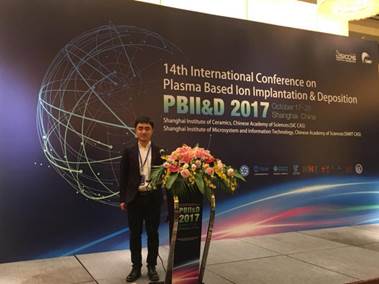Low temperature plasma technology has been successfully applied to the outer surface modification, but it still has long way to go for inner surface. Recently, however, a doctoral candidate of Beihang University, Xu Yi, has made headlines with his proposal to deposit film on the interior surface of long and slender tube.
In October 2017, the 14th International Conference on Plasma Based Ion Implantation & Deposition PBII&D 2017 was held in Shanghai. The doctoral candidate Xu Yi from the team led by Professor Li Liuhe of the School of Mechanical Engineering and Automation of Beihang University was awarded the Best Poster Award with his academic paper, which proposes the self-enhanced plasma discharge effect in the process of plasma discharge in EGD-PIII&D for the first time. The paper was spoken highly of by experts home and abroad.
The technique of low plasma surface modification is a cutting-edge technology developed from the interdisciplinary study based on physics, chemistry, electronics, etc. Widely-applied as it is today, it is still not satisfactorily available for tubes with small inside diameter and high length-diameter ratio, since the outside plasma could hardly make its way into such tubes, nor to be generated inside them.
Nowadays, however, the tubes are widely used in numerous fields such as mechanics, chemical engineering, biomedicine, and so on. For example, the existing artificial blood vessels with an inner diameter smaller than 3mm are unsatisfactory due to their fairly short service life. Therefore, the inner surface modification is in urgent need.

A model of artificial blood vessels
The EGD-PIII&D is a patent device of Xu's doctoral supervisor Li Liuhe. Once by chance Xu discovered that its special design of the spot anode and the large-area cathode target enables the generation of sufficient secondary electrons with adequate energy. The phenomenon led him to contemplate using it as the energy particle source to generate and sustain plasma inside the tubes. It is based on this inspiration that Xu applies EGD-PIII&D to the generation of plasma inside the specific type of tubes.

The EGD-PIII&D Device

Main process of self-enhanced plasma discharge effect in process of DLC thin film deposition inside the tube
Up to now, Xu’s research has progressed to a new stage where the EGD-PIII&D technique can be utilized to deposit DLC film on the inner surface of quartz tubules with an inside diameter of 0.8mm and a length over 100mm, as well as to other heterotype tubes such as spiral and C-shaped ones. Besides, Xu also manages to obtain the influence of gas flow rate and voltage on the uniformity of DLC film.

Inner surface of straight cube and heterotype quartz cube: before & after DLC thin film deposition
Speaking of his achievement, Xu attributes it to the everyday accumulation of the rich resources and cutting-edge technology in this field, as well as to the innovative ideas inspired by others’ work.
Xu has made his remarkable debut in the world’s academic arena, but we believe it is only a start, just as all other Beihang talents who are always striving for greater scientific progress.

Xu Yi at the conference
Planned and written by Jinxing Zhang, Peiyuan Li
Designed by Yanzhuo Yang
Edited and translated by Siying Li
Special thanks to Yi Xu and the School
of Mechanical Engineering and Automation
Reviewed by GEOOS
Please send contributions to geoos@buaa.edu.cn

